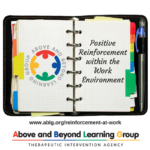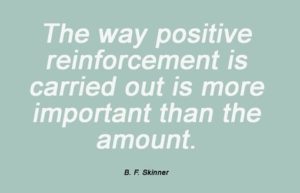 Keeping employees continuously motivated and excited about their jobs can be a difficult task. Just as we use positive reinforcement with our learners, it is beneficial to use positive reinforcement within the workplace. Employers may first ask what can be used as reinforcers. But a more important question may be how to most effectively reinforce.
Keeping employees continuously motivated and excited about their jobs can be a difficult task. Just as we use positive reinforcement with our learners, it is beneficial to use positive reinforcement within the workplace. Employers may first ask what can be used as reinforcers. But a more important question may be how to most effectively reinforce.
“Positive reinforcement is the most important and most widely applied principle of behavior analysis.”
– Cooper, Heron, and Heward (2007, p. 257)
Positive reinforcement, by definition, is the practice of following behavior with desirable consequences in order to increase the future likelihood of that behavior. For example, if a supervisor praises an employee for doing a task, he/she increases the frequency of doing that task again – positive reinforcement is in effect!
A paycheck may serve as the ultimate reinforcer for getting out of bed and going to work in the first place! But supplementing this with additional reinforcers throughout the workday may assist with a) decreasing the delay between the behavior and the reinforcer, b) ensuring appropriate stimulus conditions are in place when the response occurs, and c) shaping behavior. Let’s look at an example of each.
Behavior that occurs on Monday morning is unlikely to be positively impacted by receiving a paycheck on Friday afternoon. The reason is that the delay between the behavior and the reinforcer is too long. By using additional reinforcers, supervisors can (try to) provide positive consequences as soon as possible after the behavior occurred. For example, after a supervisor receives a phone call from a parent thanking their ABA therapists for helping their child with a difficult transition, that supervisor can immediately post a note on the public staff “shout out” board.
The use of cell phones may not seem like a behavior that a supervisor would want to reinforce at work. However, under closer inspection, the behavior of using a cell phone may be reinforced under the appropriate stimulus conditions. For example, a supervisor who witnesses an ABA therapist texting on their cell phone during a child’s break would be unlikely to reinforce this behavior. On the other hand, that same ABA therapist using their cell phone to call a parent to tell them they have a flat tire and won’t make it to the scheduled ABA session may be praised by a supervisor for letting the family know of the schedule change immediately (using their cell phone).
Finally, employees often bring wonderful skills to their job role and responsibilities. It is still common though that other skills may need to be shaped. When we use positive reinforcement to shape behavior, we provide reinforcement for behavior that approximates what we want it to ultimately look like. As the behavior gets closer and closer to the final target, reinforcement is only provided after the employee’s best approximation. Over time, only the final target receives a reinforcer as a consequence.
What could that look like in the work place? An employee is perpetually late handing in reports to their supervisor. As a result, the supervisor often provides disapproval for the employee’s performance, but decides to try a different route – one of positive reinforcement! So the supervisor decides to provide an extra 30 minutes to the employee’s lunch break if she hands in the reports within 3 days of the due date. Once the employee consistently hands in reports within the 3 day window, the supervisor will inform the employee that the longer lunch break will only be allowed after reports are handed in within 2 days of the due date. And then it will change again to within 1 day, and then on the due date, and then (finally) only when it is 1 day early! Once the reports are consistently submitted early, the supervisor can start to fade reinforcement until the behavior is maintained through natural contingencies – such as feeling good about getting your work done on time!
Aubrey Daniels, Ph.D., using the principles of behavior analysis, developed an evaluation tool (PIC/NIC Analysis) to determine how consequences may impact employee performance. Specifically, consequences which are positive/immediate/certain or negative/immediate/certain are the most powerful to impact behavior. Consequences which are delayed and/or uncertain are not as powerful. It is important to keep this in mind when deciding how to provide positive reinforcement to your employees. Here is an example:
A “refer-a-friend” incentive program, where employees who refer professional colleagues are entered into a monthly lottery drawing to earn a gift card, provides a positive consequence but it is uncertain and possibly delayed (depending on when in the month the referral was made).
Compare that with ABLG’s incentive program for new clients. When an employee refers a new client to ABLG, they are rewarded with a gift card. This system provides a positive consequence that is immediate and certain.

Just as we have reinforcement systems for our learners, it is an important tool for supervisors to impact the behavior of their employees. Remember – you’ll know the consequence you’ve provided is a reinforcer when you see an increase in that behavior in the future!
Here are some other examples of reinforcers that can be used in the work place:
http://www.forbes.com/sites/kevinkruse/2013/03/01/25-low-cost-ways-to-reward-employees/#23d2812d2233
http://www.washington.edu/admin/hr/roles/mgr/ee-recognition/award-ideas

Leave a Reply